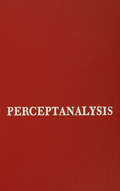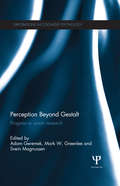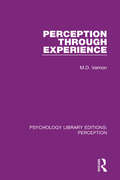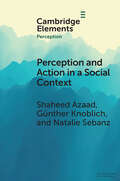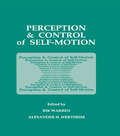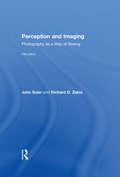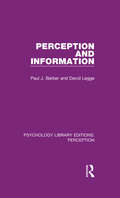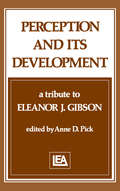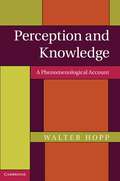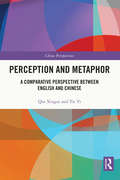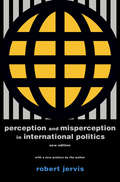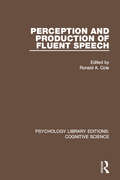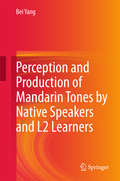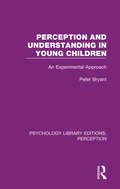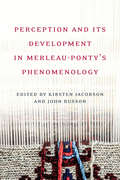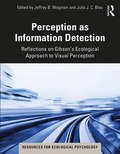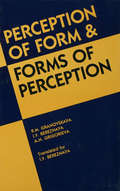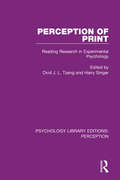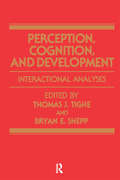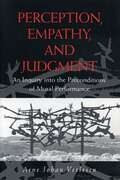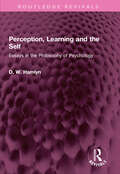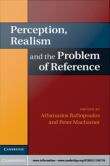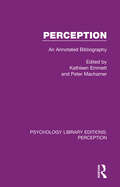- Table View
- List View
Perceptanalysis: The Rorschach Method Fundamentally Reworked, Expanded and Systematized
by Z. A. PiotrowskiFirst Published in 1987. Routledge is an imprint of Taylor & Francis, an informa company.
Perception And Cognition Of Music
by Irène Deliège John SlobodaThis text comprises of reviews of work relating to music and mind. It presents a range of approaches from the psychological through the computational, to the musicological. The reviews were selected from papers submitted at the Third International Conference on Music Perception and Cognition Liege 1994 to illustrate the wide range of perspectives now being adopted in studying how humans make and respond to music. The book is divided ino five sections. The first part illustrates the role of analysis and ethnomusicology in understanding cultural determinants of musical behaviour. The second part charts what is known about aquisition of musical competence, from pre-birth through to the expert performer. The evidence accumulated about specific areas of the brain which control musical thinking and behaviour is examined in Part Three. The fourth part examines how neurological, behavioural and artificial intelligence approaches are converging to shed light on processes in auditory perception. Finally, Part Five highlights the important developments in how we conceptualize the way in which musical structures are represented in the mind.
Perception Beyond Gestalt: Progress in vision research (Explorations in Cognitive Psychology)
by Adam Geremek Mark W. Greenlee Svein MagnussenHow does the brain piece together the information required to achieve object recognition, figure-ground segmentation, object completion in cases of partial occlusion and related perceptual phenomena? This book focuses on principles of Gestalt psychology and the key issues which surround them, providing an up-to-date survey of the most interesting and highly debated topics in visual neuroscience, perception and object recognition. The volume is divided into three main parts: Gestalt and perceptual organisation, attention aftereffects and illusions, and color vision and art perception. Themes covered in the book include: - a historical review of Gestalt theory and its relevance in modern-day neuroscience- the relationship between perceptive and receptive fields- a critical analysis of spatiotemporal unity of perception- the role of Gestalt principles in perceptual organization- self-organizing properties of the visual field- the role of attention and perceptual grouping in forming non-retinotopic representations- figural distortions following adaptation to spatial patterns- illusory changes of brightness in spatial patterns- the function of motion illusions as a tool to study Gestalt principles in vision- conflicting theories of color vision and the neural basis of it- the role of color in figure-ground segmentation- chromatic assimilation in visual art and perception- the phenomena of colored shadows.Including contributions from experts in the field, this book will provide an essential overview of current research and theory on visual perception and Gestalt. It will be key reading for researchers and academics in the field of visual perception and neuroscience.
Perception Through Experience (Psychology Library Editions: Perception #30)
by M.D. VernonThe term ‘visual perception’ covers a very wide range of psychological functions. This title, originally published in 1970, which provides a broad survey of this vast field of knowledge, would have proved a valuable general account for students taking degree courses in psychology at the time. Professor Vernon examines a large number of experiments carried out over the previous twenty years, their findings, the conclusions drawn from them, and – equally important – the still unanswered questions which some of them raised. As the title suggests, Professor Vernon considers that – while much knowledge of the simpler perceptual processes had been gained in laboratory experiments – perhaps too little investigation had been undertaken into the more complex processes which normally determine understanding of and response to environment: the processes of identification and classification that depend to a considerable extent on learning, memory, attention, reasoning and language. An extensive bibliography is provided.
Perception and Action in a Social Context (Elements in Perception)
by Shaheed Azaad Günther Knoblich Natalie SebanzEven the simplest social interactions require us to gather, integrate, and act upon, multiple streams of information about others and our surroundings. In this Element, we discuss how perceptual processes provide us with an accurate account of action-relevant information in social contexts. We overview contemporary theories and research that explores how: (1) individuals perceive others' mental states and actions, (2) individuals perceive affordances for themselves, others, and the dyad, and (3) how social contexts guide our attention to modulate what we perceive. Finally, we review work on the cognitive mechanisms that make joint action possible and discuss their links to perception.
Perception and Control of Self-motion (Resources for Ecological Psychology Series)
by Rik Warren Alexander H. WertheimThis book presents studies of self-motion by an international group of basic and applied researchers including biologists, psychologists, comparative physiologists, kinesiologists, aerospace and control engineers, physicians, and physicists. Academia is well represented and accounts for most of the applied research offered. Basic theoretical research is further represented by private research companies and also by government laboratories on both sides of the Atlantic. Researchers and students of biology, psychology, physiology, kinesiology, engineering, and physics who have an interest in self-motion -- whether it be underwater, in space, or on solid ground -- will find this volume of interest. This book presents studies of self-motion by an international group of basic and applied researchers including biologists, psychologists, comparative physiologists, kinesiologists, aerospace and control engineers, physicians, and physicists. Academia is well represented and accounts for most of the applied research offered. Basic theoretical research is further represented by private research companies and also by government laboratories on both sides of the Atlantic. Researchers and students of biology, psychology, physiology, kinesiology, engineering, and physics who have an interest in self-motion -- whether it be underwater, in space, or on solid ground -- will find this volume of interest.
Perception and Imaging: Photography as a Way of Seeing
by John Suler Richard D. ZakiaWhen you look at an image, what do you see and feel? What do you want your audience to see and feel when they view your work? For over thirty years, Dr. Richard Zakia helped thousands of photographers hone in on their creative vision through the inspirational, informative text and images included in his classic book, Perception and Imaging. More than a step-by-step photography instruction manual, Perception and Imaging explores the fundamental act of photography – seeing – through a uniquely comprehensive combination of technique, history, visual perception, philosophy and psychology. No matter your level of technical skill, you can learn to think more clearly about what you wish to convey in your images. Fully revised to account for the unique influences and consequences of the digital revolution and online photosharing, John Suler newly addresses digital impermanence, sensory and cognitive overload, and the selfie, and their effects on perception. Additional coverage also includes microexpressions, Rorschach inkblots and subliminal reactions, transference, and synectics.
Perception and Information (Psychology Library Editions: Perception #1)
by Paul J. Barber David LeggePerception is about the reception, selection, acquisition, transformation and organization of sensory information. This book, originally published in 1976, discusses a number of aspects of human perception within a theoretical framework in which man is considered as a processor of information. The main emphasis is on visual perception with particular reference to looking and pattern recognition; selective listening and speech recognition are also discussed.
Perception and Its Development: A Tribute To Eleanor J. Gibson
by Anne D. PickWe have acquired important new knowledge about the nature and development of perception in recent years, and the insights of Eleanor Jack Gibson have had a prominent role in guiding the search for that knowledge. The purpose of this volume is to honor her continuing conrbution to our understanding of perception. First published in 1979. Routledge is an imprint of Taylor & Francis, an informa company.
Perception and Knowledge: A Phenomenological Account
by Walter HoppThis book offers a provocative, clear and rigorously argued account of the nature of perception and its role in the production of knowledge. Walter Hopp argues that perceptual experiences do not have conceptual content, and that what makes them play a distinctive epistemic role is not the features which they share with beliefs, but something that in fact sets them radically apart. He explains that the reason-giving relation between experiences and beliefs is what Edmund Husserl called 'fulfilment' - in which we find something to be as we think it to be. His book covers a wide range of central topics in contemporary philosophy of mind, epistemology and traditional phenomenology. It is essential reading for contemporary analytic philosophers of mind and phenomenologists alike.
Perception and Metaphor: A Comparative Perspective Between English and Chinese (China Perspectives)
by Qin Xiugui Tie YiCognitive linguists believe that metaphors are prevalent in human thought, while metaphorical structures are reflected at the linguistic level. Therefore, analysing extensive language data can aid in revealing the metaphorical mappings of embodied experience with the senses of vision, hearing, smell, taste, touch, and temperature. This volume seeks to discover the similarities and differences between the metaphorical systems of the English and Chinese languages. Adopting a comparative view, the authors examine the semantic extensions of perception words in English and Chinese, in order to reveal the metaphorical scope of each sense and the metaphorical system behind it. They argue that the metaphorical systems of the senses not only help us understand and use conventionalised metaphorical expressions but also allow us to create novel expressions. The findings also unveil how abstract concepts are constructed via cognitive mechanisms, such as image schema and metaphor. This title is a useful reference for scholars and students who are interested in cognitive linguistics, comparative linguistics, and the philosophy of language.
Perception and Misperception in International Politics
by Robert JervisWith a new preface by the authorSince its original publication in 1976, Perception and Misperception in International Politics has become a landmark book in its field, hailed by the New York Times as "the seminal statement of principles underlying political psychology." This new edition includes an extensive preface by the author reflecting on the book's lasting impact and legacy, particularly in the application of cognitive psychology to political decision making, and brings that analysis up to date by discussing the relevant psychological research over the past forty years. Jervis describes the process of perception (for example, how decision makers learn from history) and then explores common forms of misperception (such as overestimating one's influence). He then tests his ideas through a number of important events in international relations from nineteenth- and twentieth-century European history. Perception and Misperception in International Politics is essential for understanding international relations today.
Perception and Production of Fluent Speech (Psychology Library Editions: Cognitive Science)
by Ronald A. ColeOriginally published in 1980, this title looks at the mental processes involved in producing and understanding spoken language. Although there had been several edited volumes on speech in the previous ten years, this volume was unique in that it deals exclusively with perception and production of fluent speech. The chapters in this volume, contributed to by distinguished scientists from psychology, linguistics and computer science, deal with such questions as: How are ideas encoded into sound? How does a speaker plan an utterance? How are words recognized? What is the role of knowledge in speech perception? In short, how do people communicate with each other using speech?
Perception and Production of Mandarin Tones by Native Speakers and L2 Learners
by Bei YangTones are the most challenging aspect of learning Chinese as a second language, and L2 learners' perceptual categories differ in important and fascinating ways from those of native speakers. This book explores the relationship between tone perception and production among native speakers and non-native learners as illustrated in the experiments the author conducted with native speakers, true learners and heritage learners, all of whom were tested on their ability to produce tones naturally and to perceive 81 synthesized tones in various contexts. The experiments show that each group processes tones differently with regard to both register (tonal level) and contour (tonal shape). The results also reveal how three types of cues - acoustic, psychological and contextual - influence non-native speakers' tone perception and production.
Perception and Understanding in Young Children: An Experimental Approach (Psychology Library Editions: Perception #4)
by Peter BryantOriginally published in 1974: ‘This book sets forth a theory of cognitive development based on simple but powerful processes of inference. The theory is applied with great ingenuity and freshness to complex phenomena found during intellectual development. Dr Bryant has written an important and original book.’ (J.S. Bruner) ‘In this elegant, timely and brief volume, Dr Bryant produces strong experimental evidence which not only challenges Piaget’s ideas, but even more importantly synthesizes the old and new findings into a newer theory of perceptual development. The importance of this book lies both in its demonstration of elegant experimental techniques in working with young children, and in the optimism it will eventually bring to all concerned with their education. Realizing that children can make deductive inferences at an early age, educators will have to rethink some of their approaches to the teaching of young children. The studies related to the understanding of number have crucial implications for the future teaching of mathematics. This book will cause many people to take fresh thoughts on the subjects here dealt with, and so it can be strongly recommended for all students of child development.’ (William Yule, British Journal of Psychiatry)
Perception and its Development in Merleau-Ponty's 'Phemenology'
by John Russon Kirsten JacobsonFrench phenomenologist Maurice Merleau-Ponty (1908–1961) shifted the terrain of western philosophy when he identified the body, rather than consciousness, as the primary site of our meaningful engagement with the world. His magnum opus, The Phenomenology of Perception (1945), revolutionized work in philosophy, psychology, cognitive science and other fields. Perception and Its Development in Merleau-Ponty’s Phenomenology brings together essays from fifteen leading Merleau-Ponty scholars to demonstrate the continuing significance of Merleau-Ponty’s analysis. Mirroring the progression found in Merleau-Ponty's Phenomenology of Perception, the essays in this volume engage in original phenomenological research to demonstrate the dynamic development of perceptual life from perception's most foundational forms (spatiality, temporality, intentionality, etc.) to its richest articulations in political life and artistic activity. This comprehensive volume is a powerful resource for students and scholars alike studying Merleau-Ponty’s philosophy and serves both as a commentary upon and companion to his The Phenomenology of Perception.
Perception as Information Detection: Reflections on Gibson’s Ecological Approach to Visual Perception (Resources for Ecological Psychology Series)
by Jeffrey B. Wagman Julia J. C. BlauThis book provides a chapter-by-chapter update to and reflection on of the landmark volume by J.J. Gibson on the Ecological Approach to Visual Perception (1979). Gibson’s book was presented a pioneering approach in experimental psychology; it was his most complete and mature description of the ecological approach to visual perception. Perception as Information Detection commemorates, develops, and updates each of the sixteen chapters from Gibson’s volume. The book brings together some of the foremost perceptual scientists in the field, from the United States, Europe, and Asia, to reflect on Gibson’s original chapters, expand on the key concepts discussed and relate this to their own cutting-edge research. This connects Gibson’s classic with the current state of the field, as well as providing a new generation of students with a contemporary overview of the ecological approach to visual perception. Perception as Information Detection is an important resource for perceptual scientists as well as both undergraduates and graduates studying sensation and perception, vision, cognitive science, ecological psychology, and philosophy of mind.
Perception as Information Detection: Reflections on Gibson’s Ecological Approach to Visual Perception (Resources for Ecological Psychology Series)
by Jeffrey B. Wagman Julia J. C. BlauThis book provides a chapter-by-chapter update to and reflection on of the landmark volume by J.J. Gibson on the Ecological Approach to Visual Perception (1979).Gibson’s book was presented a pioneering approach in experimental psychology; it was his most complete and mature description of the ecological approach to visual perception. Perception as Information Detection commemorates, develops, and updates each of the sixteen chapters from Gibson’s volume. The book brings together some of the foremost perceptual scientists in the field, from the United States, Europe, and Asia, to reflect on Gibson’s original chapters, expand on the key concepts discussed and relate this to their own cutting-edge research. This connects Gibson’s classic with the current state of the field, as well as providing a new generation of students with a contemporary overview of the ecological approach to visual perception.Perception as Information Detection is an important resource for perceptual scientists as well as both undergraduates and graduates studying sensation and perception, vision, cognitive science, ecological psychology, and philosophy of mind.
Perception of Form and Forms of Perception
by R. M. Granovskaya I. J. Bereznaya Alla N. GrigorievaFirst Published in 1987. Information processing has come to be regarded as one of the central issues in modern psychology. In recent years it has acquired an especially keen interest due to growing amounts of information. This book continues the authors’ research and constructs a conceptual model of peculiarities (separate aspects) of visual information processing based on views similar to those by Arbib and Ivanov.
Perception of Print: Reading Research in Experimental Psychology (Psychology Library Editions: Perception #28)
by Ovid J. L. Tzeng and Harry SingerIn the late 1970s, reading research had become a true interdisciplinary endeavour with flavours of anthropology, artificial intelligence, cognitive psychology, educational psychology, linguistics, neuroscience and instructional technology. Given appropriate integration, results from these diverse perspectives can enhance our understanding of reading behaviour tremendously, both in its acquisition and in its skilled functioning. Thus, the enthusiasm for such interdisciplinary interaction had been quite intense for some time. In the years before publication, the National Reading Conference had been doing everything possible to accelerate this interaction. Originally published in 1981, the chapters in this book are the fruits of that effort. The research focuses on specifying skills in identifying alphabetical elements and the rules that govern their combination, on constructing models that characterize the recognition of individual words and the interpretation of texts, and on discovering what factors are responsible for blocking the normal acquisition process in many children. Chapters 2 to 12 of this book reflect these changing foci. They are nevertheless sandwiched by two chapters that deal with the historical background and future outlook of reading instruction.
Perception, Cognition, and Development: Interactional Analyses
by Thomas J. Tighe and Bryan E. SheppThis volume is based on a conference held at Dartmouth College’s Minary Conference Center in Holdemess, New Hampshire, June 4 -7 , 1981. The conference brought together a number of investigators whose separate lines of inquiry bear in significant ways on the relationships among perception, cognition, and development. The purpose was to consider interactions among these basic processes not only as a critical facet of the research programs of the participants but also as a central conceptual problem for current theoretical psychology. First published in 1983. Routledge is an imprint of Taylor & Francis, an informa company.
Perception, Empathy, and Judgment: An Inquiry into the Preconditions of Moral Performance (G - Reference, Information and Interdisciplinary Subjects)
by Arne Johan VetlesenIn Perception, Empathy, and Judgment Arne Johan Vetlesen focuses on the indispensable role of emotion, especially the faculty of empathy, in morality. He contends that moral conduct is severely threatened once empathy is prevented from taking part in an interplay with cognitive faculties (such as abstraction or imagination) in acts of moral perception and judgment. Drawing on developmental psychology, especially British "object relations" theory, to illuminate the nature and functioning of empathy, Vetlesen shows how moral performance is constituted by a sequence involving perception, judgment, and action, with an interplay between the agent's emotional (empathic) and cognitive faculties occurring at each stage. In the powerful tradition from Kant to present-day theorists such as Kohlberg, Rawls, and Habermas, reason is privileged over feeling and judgment over perception, in such a way that basic philosophical questions remain unasked. Vetlesen focuses our attention on these questions and challenges the long-standing assertion that emotions are damaging to moral response. In the final chapter he relates his argument to recent feminist critiques that have also castigated moral theorists in the Kantian tradition for their refusal to recognize a role for emotion in morality. While the book's argument is philosophical, its method and scope are interdisciplinary. In addition to critiques of such philosophers as Arendt, MacIntyre, and Habermas, it contains discussions of specific historical, ideological, and sociological factors that may cause "numbing"—selective or broad-ranging, pathological insensitivity—in humans. The Nazis' mass killing of Jews is studied to illuminate these and other relevant empirical aspects of large-scale immoral action.
Perception, Learning and the Self: Essays in the Philosophy of Psychology (Routledge Revivals)
by D. W. HamlynFirst published in 1983, Perception, Learning and the Self is a collection of essays demonstrating the incompleteness of the information-processing model in cognitive psychology and the connection between epistemic factors and social conditions in the making of the self. It is suggested that any framework employed to view cognition must be an essentially social one, in which knowers are seen as selves who are agents with feelings and attitudes. Professor Hamlyn argues that, by failing to acknowledge this social element, the information-processing model presents an overly simplistic view of the systems that underlie cognition, and thus is liable to distort what is at stake. Professor Hamlyn considers the contributions of a number of major psychologists to this area of study, including James Gibson, Jean Piaget and Sigmund Freud. This book will be of interest to students of philosophy and psychology.
Perception, Realism, and the Problem of Reference
by Athanassios Raftopoulos Peter MachamerOne of the perennial themes in philosophy is the problem of our access to the world around us; do our perceptual systems bring us into contact with the world as it is or does perception depend upon our individual conceptual frameworks? This volume of new essays examines reference as it relates to perception, action and realism, and the questions which arise if there is no neutral perspective or independent way to know the world. The essays discuss the nature of referring, concentrating on the way perceptual reference links us with the observable world, and go on to examine the implications of theories of perceptual reference for realism and the way in which scientific theories refer and thus connect us with the world. They will be of interest to a wide range of readers in philosophy of psychology, cognitive science and action theory.
Perception: An Annotated Bibliography (Psychology Library Editions: Perception #7)
by Peter Machamer Kathleen EmmettOriginally published in 1976, the bibliography presented here was intended to provide a useful research tool for scholars and students of perception. The primary concentration of the authors’ efforts has been on the philosophical literature during the period of 1935-1974.
